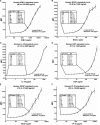Urinary biomarkers for sensitive and specific detection of acute kidney injury in humans
- PMID: 19212447
- PMCID: PMC2638059
- DOI: 10.1111/j.1752-8062.2008.00053.x
Urinary biomarkers for sensitive and specific detection of acute kidney injury in humans
Abstract
Acute kidney injury (AKI) is associated with high morbidity and mortality. The lack of sensitive and specific injury biomarkers has greatly impeded the development of therapeutic strategies to improve outcomes of AKI.The unique objective of this study was to evaluate the diagnostic performance of nine urinary biomarkers of AKI-kidney injury molecule-1 (KIM-1), neutrophil gelatinase associated lipocalin (NGAL), interleukin-18 (IL-18), hepatocyte growth factor (HGF), cystatin C (Cys), N-acetyl-beta-D-glucosaminidase (NAG), vascular endothelial growth factor (VEGF), chemokine interferon-inducible protein 10 (IP-10; CXCL10), and total protein-in a cross-sectional comparison of 204 patients with or without AKI.Median urinary concentrations of each biomarker were significantly higher in patients with AKI than in those without AKI (p < 0.001). The area under the receiver operating characteristics curve (AUC-ROC) for the combination of biomarkers using a logic regression model [risk score of 2.93*(NGAL > 5.72 and HGF > 0.17) + 2.93*(PROTEIN > 0.22) -2*(KIM < 0.58)] was greater (0.94) than individual biomarker AUC-ROCs. Age-adjusted levels of urinary KIM-1, NAG, HGF, VEGF, and total protein were significantly higher in patients who died or required renal replacement therapy (RRT) when compared to those who survived and did not require RRT.Our results demonstrate the comparative value of multiple biomarkers in the diagnosis and prognosis of AKI.
Keywords: acute kidney injury; biomarkers; hepatocyte growth factor; kidney injury molecule-1; neutrophil gelatinase associated lipocalin.
Figures



Similar articles
-
Urinary calprotectin, kidney injury molecule-1, and neutrophil gelatinase-associated lipocalin for the prediction of adverse outcome in pediatric acute kidney injury.Eur J Pediatr. 2017 Jun;176(6):745-755. doi: 10.1007/s00431-017-2907-y. Epub 2017 Apr 14. Eur J Pediatr. 2017. PMID: 28409285 Clinical Trial.
-
Diagnostic performance of urinary kidney injury molecule-1 and neutrophil gelatinase-associated lipocalin for acute kidney injury in an obstructive nephropathy patient.Nephrology (Carlton). 2014 Apr;19(4):186-94. doi: 10.1111/nep.12173. Nephrology (Carlton). 2014. PMID: 24165570
-
Biomarker Predictors of Adverse Acute Kidney Injury Outcomes in Critically Ill Patients: The Dublin Acute Biomarker Group Evaluation Study.Am J Nephrol. 2019;50(1):19-28. doi: 10.1159/000500231. Epub 2019 Jun 14. Am J Nephrol. 2019. PMID: 31203271
-
Urinary, Plasma, and Serum Biomarkers' Utility for Predicting Acute Kidney Injury Associated With Cardiac Surgery in Adults: A Meta-analysis.Am J Kidney Dis. 2015 Dec;66(6):993-1005. doi: 10.1053/j.ajkd.2015.06.018. Epub 2015 Aug 5. Am J Kidney Dis. 2015. PMID: 26253993 Review.
-
Urinary and serum biomarkers for the diagnosis of acute kidney injury: an in-depth review of the literature.Nephrol Dial Transplant. 2013 Feb;28(2):254-73. doi: 10.1093/ndt/gfs380. Epub 2012 Oct 31. Nephrol Dial Transplant. 2013. PMID: 23115326 Review.
Cited by
-
Sepsis-Associated Acute Kidney Injury.Crit Care Clin. 2021 Apr;37(2):279-301. doi: 10.1016/j.ccc.2020.11.010. Epub 2021 Feb 13. Crit Care Clin. 2021. PMID: 33752856 Free PMC article. Review.
-
A Quantitative Approach to Screen for Nephrotoxic Compounds In Vitro.J Am Soc Nephrol. 2016 Apr;27(4):1015-28. doi: 10.1681/ASN.2015010060. Epub 2015 Aug 10. J Am Soc Nephrol. 2016. PMID: 26260164 Free PMC article.
-
Acute kidney injury during an ultra-distance race.PLoS One. 2019 Sep 25;14(9):e0222544. doi: 10.1371/journal.pone.0222544. eCollection 2019. PLoS One. 2019. PMID: 31553742 Free PMC article.
-
The Nephroprotective Effects of α-Bisabolol in Cisplatin-Induced Acute Kidney Injury in Mice.Biomedicines. 2022 Apr 3;10(4):842. doi: 10.3390/biomedicines10040842. Biomedicines. 2022. PMID: 35453592 Free PMC article.
-
Regression of microalbuminuria in type 1 diabetes is associated with lower levels of urinary tubular injury biomarkers, kidney injury molecule-1, and N-acetyl-β-D-glucosaminidase.Kidney Int. 2011 Feb;79(4):464-70. doi: 10.1038/ki.2010.404. Epub 2010 Oct 27. Kidney Int. 2011. PMID: 20980978 Free PMC article.
References
-
- Chertow GM, Burdick E, Honour M, Bonventre JV, Bates DW. Acute kidney injury, mortality, length of stay, and costs in hospitalized patients. J Am Soc Nephrol. 2005; 16: 3365–3370. - PubMed
-
- Star RA. Treatment of acute renal failure. Kidney Int. 1998; 54: 1817–1831. - PubMed
-
- Woosley RL, Cossman J. Drug development and the FDAs Critical Path Initiative. Gin Pharmacol Ther. 2007; 81: 129–133. - PubMed
-
- Hewitt SM, Dear J, Star RA. Discovery of protein biomarkers for renal diseases. J Am Soc Nephrol. 2004; 15: 1677–1689. - PubMed
Publication types
MeSH terms
Substances
Grants and funding
- K23 DK075941/DK/NIDDK NIH HHS/United States
- R33 DK074099-04/DK/NIDDK NIH HHS/United States
- R37 DK039773/DK/NIDDK NIH HHS/United States
- DK72831/DK/NIDDK NIH HHS/United States
- R33 DK074099/DK/NIDDK NIH HHS/United States
- K23 DK075941-02/DK/NIDDK NIH HHS/United States
- R21 DK074099/DK/NIDDK NIH HHS/United States
- DK74099/DK/NIDDK NIH HHS/United States
- R00 ES016723/ES/NIEHS NIH HHS/United States
- K99 ES016723/ES/NIEHS NIH HHS/United States
- R00 ES016723-02/ES/NIEHS NIH HHS/United States
- R01 DK072381/DK/NIDDK NIH HHS/United States
- DK39773/DK/NIDDK NIH HHS/United States
- K99/R00 ES16723/ES/NIEHS NIH HHS/United States
- R01 DK039773/DK/NIDDK NIH HHS/United States
- K99 ES016723-01/ES/NIEHS NIH HHS/United States
LinkOut - more resources
Full Text Sources
Other Literature Sources
Miscellaneous

